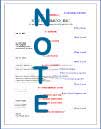ViaSyl -- Business Communication
Focus: Business Communications Formats
|
|
You are here: MemosMemos Memos are the most common form of intra-organizational communication. Memos, short for memorandums, are, as the name suggests, a form of business communication with the purpose of information documentation and distribution, mostly within an organization. Memos are used within an organization to present a very specific subject, to all relevant individuals or departments from an individual or team. Memos follow a conventional format. They may have a distribution list of receivers that may at times be very long. Memos are generally written in a format established by the organization. Memos use the following four items at the top of the page or below the letterhead
The responses to the four items should line up with the use of tabs set for the longest item, the subject.
There should be at least two spaces after the subject colon, so that each item will be aligned and clearly visible and the pattern of spacing will add further structure to the memo. Sometimes added to the items are the abbreviated forms: CC (for copies) and the substitute of Re: for Subject in the items. To write effective memos you should
. An excellent guide to w:riting memos is at the following website: Purdue's Online Writing Lab (OWL) TheIr discussion begins:
If you're ready to go beyond the basics of format and into matters of rhetoric, give the site a look, you'll find many useful suggestions. Pay special attention to the discussion on the organization of content, with the subject and most important information first and elaborations later. Your memo should be designed to highlight information you deem essential for your readers, including the goal-setters, decision-makers and planning implementers receiving the memo. |
 You may have a wordprocessor that provides a memo wizard or template that you could adapt for your needs. If you have Microsoft Word, a template for what they call an "elegant" memo is available for free download at the MS Office template website
You may have a wordprocessor that provides a memo wizard or template that you could adapt for your needs. If you have Microsoft Word, a template for what they call an "elegant" memo is available for free download at the MS Office template website